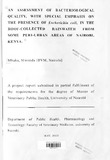An assessment of bacteriological quality, with special emphasis on the presence of escherichia coli, in the roof -collected rainwater from some peri-urban areas of Nairobi, Kenya
Abstract
Rainwater is g a i n i n g importance as a supplementary source of
drinking water, especially in the peri-urban zones of Nairobi,
where piped water is not available, or the supply is irregular.
The ground water sources, boreholes and wells, may be
unsuitable due to unpleasant odours and taste, or microbial
contamination.
Studies addressing the public health suitability of rainwater for
drinking purposes are lacking in this country and the region.
The present study was conducted to determine the presence of
Escherichia coli [E. coli} in rainwater harvested for human
consumption. This study was conducted in Ngong Division of
Kajiado District, Kikuyu Division of Kiambu District and
Dagoretti Division of Nairobi Province. These divisions are
found in the neighbourhood of the city of Nairobi, Kenya, and
w ere purposely selected . Collection of sample s was don e fro m
regions where people cons urn e rain w at er stored in reservoir tanks.
An area with a rich tree cover, moderate tree cover, and a
pre d 0 m in an tl y res ide n t i aIr e g 10 n we res e 1e c te d for sam p li n g .
Li v e s to c k k e ep in g and c r 0p far m in g was don e in the sea rea s to
varying degrees. The homes selected for samplin g from were those
convenientl y situ ate d alo ng th e commonly used roads in the study
area.
Rainwater samples were collected from water tanks. The roofs
were made of either concrete roofing-tiles or galvanized
corrugated i r o n sheets. The water tanks were made of
galvanized iron sheets, concrete (or ferro-concrete), or plastic.
Bacteriological analyses were done to determine the
microbiological quality of water from the sources. The total
viable count of the microorganisms was assessed using the pour
plate method. The most probable number of coliforms was
determined using the multiple tube fermentation technique. The
presence of E. coli was determined by biochemical reactions of
Indole, Methyl Red, Voges Proskauer, and fermentation of
Citrate.
Eighty-nine (89) water samples were collected; 29 from
Dagoretti Division, 31 from Ngong Division, and 29 from
Kikuyu Division. The TVC per ml of the water samples ranged
between 0 and 1.02x107 in Dagoretti and Ngong while it ranged
between 0 and 8.0x105 in Kikuyu. In Dagoretti, the mean TVC
was 1.665x106 with a standard deviation (SD) of 2.995X106
while in Ngong it was 8.236x105 with an SD of 2.545X106 and
in Kikuyu it was 7.756x104 with an SD of 1.837X105
. The most
probable number (MPN) of coliforms per lOOmIs of water
sample ranged between 0 and 1609 in the 3 Divisions. The
means were 684 with an SD of 780 for the area, 740 and an SD
of 734 for Dagoretti, 652 and an SD of 641 for Ngong, and 891
with an SD of 729 for Kikuyu. In the study area, 89% of the
samples screened tested positive for general coliforms, with
40% testing positive for E. coli. Area-wise, 83% of the samples
from Dagoretti tested positive for coliforms and 31 % for E.
coli; 87% from Ngong were positive for coliforms and 55% for
E. coli, while in Kikuyu 97% tested positive to coliforms and
34% for E. coli.
An analysis of the v a r ria n c e In the TVC of water samples from
the three divisions showed that there was no significant
difference between Dagoretti and Ngong, but that both
divisions had a significantly higher TVC than Kikuyu [p
0.033].
Of the 29 samples from Dagoretti, 24% had less than 3
coliforms per lOOmIs, 28% less than 10 coliforms, and 72%
more than 10 coliforms per lOOmIs; in Ngong it was 19%,23%
and 77% respectively, while in Kikuyu it was 7%, 17% and 83%
respectively.
Seventy-eight percent (69/89) of the samples collected
contained more than 10 coliforms per lOOmIs of water, and
therefore failed the Kenya Bureau of Standard's requirement
for un-piped drinking water. Eighty-three percent (74/89) of
the samples of the samples in the study area had more than 3
coliforms per lOOmIs of water and therefore failed the World
Health Organization's standard for untreated drinking water. It
was therefore concluded that rainwater from the study region
should be treated before consumption.
Citation
Master of Veterinary Public Health,Publisher
University of Nairobi Department of Public Health, Pharmacology and Toxicology, University of Nairobi, Kenya

